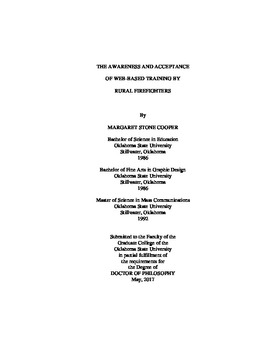| dc.contributor.advisor | Asino, Tutaleni I. | |
| dc.contributor.author | Cooper, Margaret Stone | |
| dc.date.accessioned | 2018-03-13T18:15:31Z | |
| dc.date.available | 2018-03-13T18:15:31Z | |
| dc.date.issued | 2017-05 | |
| dc.identifier.uri | https://hdl.handle.net/11244/54509 | |
| dc.description.abstract | Fire service agencies recognize the potential for distance education to help reduce the number of accidents and injuries experienced by firefighters, and many have implemented web-based delivery systems. However, little information exists concerning rural firefighters' knowledge and use of web-based training. | |
| dc.description.abstract | This exploratory study consisted of five survey sessions conducted at rural departments located in different counties in South Carolina. Participants included firefighters who attended a regular training meeting at one of the five locations. The group included mostly Caucasian males, with ages ranging from 20 to 78. A printed questionnaire served as the data collection source, which addressed access to technology, sources for training information, previous training experience, opinions concerning web-based training, and possible improvements for web-based training delivery. Fifty-four firefighters submitted valid questionnaires. | |
| dc.description.abstract | Rogers' Diffusion of Innovations served as a theoretical framework to determine whether rural firefighters knew about web-based training and had made the decision to use it. Rogers described the decision to adopt an innovation as a five-stage process. This study discussed the diffusion of web-based training in the context of the knowledge and persuasion stages of the adoption process. The data analysis showed the level of awareness of web-based training was extremely low. The one-way analysis of variance test showed that the level of awareness significantly differed according to age. Post hoc comparisons indicated the statistically significant difference occurred between those in their 40s, who were the most aware of web-based training, and those over 60, who were the least aware. Comparisons based on other demographic characteristics were not significant. Likert-type items for the level of persuasion to use web-based training indicated views toward it were only slightly more favorable than unfavorable. Respondents reported the lack of high-speed internet as the primary barrier to web-based training. Other factors included limited free time, no access to a computer, a lack of web-based training experience, and not knowing about web-based training opportunities. Technology grants for fire stations, improved marketing efforts, and in-person demonstrations on how to use a web-based course could increase its adoption. | |
| dc.format | application/pdf | |
| dc.language | en_US | |
| dc.rights | Copyright is held by the author who has granted the Oklahoma State University Library the non-exclusive right to share this material in its institutional repository. Contact Digital Library Services at lib-dls@okstate.edu or 405-744-9161 for the permission policy on the use, reproduction or distribution of this material. | |
| dc.title | Awareness and acceptance of web-based training by rural firefighters | |
| dc.contributor.committeeMember | Stansberry, Susan L. | |
| dc.contributor.committeeMember | Thompson, Penny | |
| dc.contributor.committeeMember | Ivey, Toni Ann | |
| osu.filename | Cooper_okstate_0664D_15134.pdf | |
| osu.accesstype | Open Access | |
| dc.type.genre | Dissertation | |
| dc.type.material | Text | |
| thesis.degree.discipline | Educational Technology | |
| thesis.degree.grantor | Oklahoma State University | |
